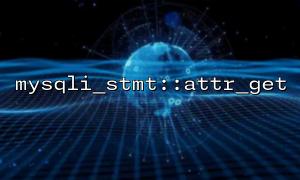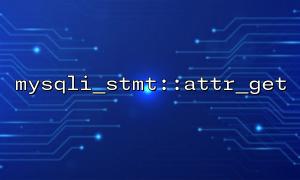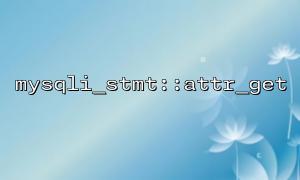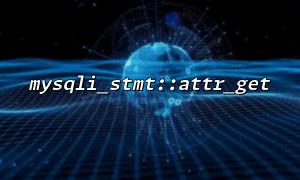When working with MySQL databases in PHP, the mysqli extension provides a rich object-oriented interface to enhance flexibility and security in database interaction. Among them, the mysqli_stmt::attr_get function is an important method used to retrieve properties of prepared statement objects. This article will focus on explaining the role of the MYSQLI_STMT_ATTR_UPDATE_MAX_LENGTH property in the mysqli_stmt::attr_get function and its specific application scenarios, along with example code to help understand it.
mysqli_stmt::attr_get is used to retrieve the value of a specific property of the current prepared statement (mysqli_stmt). Its function signature is as follows:
public mysqli_stmt::attr_get(int $attr): mixed
The parameter $attr is the identifier of the property to retrieve, and the function returns the current value of that property.
MYSQLI_STMT_ATTR_UPDATE_MAX_LENGTH is a constant property of mysqli_stmt, which controls whether the maximum length of strings or binary fields in bound variables is automatically updated when a query is executed using mysqli_stmt.
Specifically:
When this property is set to true (or non-zero), after executing the query, mysqli_stmt automatically updates the maximum length of the bound variables. This is particularly important when dealing with result sets that contain variable-length string fields, as it ensures the length of the bound variables matches the actual data length returned by the database, preventing truncation or memory overflow issues.
By default, this property is set to false, meaning that the maximum length of bound variables will not be automatically updated.
In other words, enabling this property ensures that the length of the variables reflects the true result length after retrieving the data, improving the accuracy of data handling.
Dynamic Length Text Field Handling
When a query involves variable-length string fields such as VARCHAR or TEXT, enabling this property allows for automatic adjustment of the bound variable length, ensuring the complete data is read.
Large Data Sets and Multi-Field Queries
In complex queries or large result set processing, ensuring the bound variable length is synchronized helps prevent data truncation and unexpected errors.
Binary Data Operations
When handling binary data such as BLOB, enabling this property ensures that the maximum length is automatically adjusted, preventing data loss.
The following example demonstrates how to use mysqli_stmt::attr_get and mysqli_stmt::attr_set to manipulate the MYSQLI_STMT_ATTR_UPDATE_MAX_LENGTH property:
<?php
$mysqli = new mysqli("m66.net", "username", "password", "database");
<p>if ($mysqli->connect_errno) {<br>
die("Connection failed: " . $mysqli->connect_error);<br>
}</p>
<p>// Prepared statement, query data with variable-length fields<br>
$stmt = $mysqli->prepare("SELECT name, description FROM products WHERE id = ?");</p>
<p>if (!$stmt) {<br>
die("Preparation failed: " . $mysqli->error);<br>
}</p>
<p>$id = 1;<br>
$stmt->bind_param("i", $id);</p>
<p>// Set the attribute to enable automatic update of the maximum length<br>
$stmt->attr_set(MYSQLI_STMT_ATTR_UPDATE_MAX_LENGTH, true);</p>
<p>// Execute the statement<br>
$stmt->execute();</p>
<p>// Get the current attribute value to check if it has been applied<br>
$attrValue = $stmt->attr_get(MYSQLI_STMT_ATTR_UPDATE_MAX_LENGTH);<br>
echo "MYSQLI_STMT_ATTR_UPDATE_MAX_LENGTH current value: " . ($attrValue ? "Enabled" : "Disabled") . "\n";</p>
<p>// Bind result variables<br>
$stmt->bind_result($name, $description);</p>
<p>// Retrieve data<br>
while ($stmt->fetch()) {<br>
echo "Product name: $name\n";<br>
echo "Description length: " . strlen($description) . "\n"; // Indicates that the length has been updated based on actual data<br>
echo "Description: $description\n";<br>
}</p>
<p>$stmt->close();<br>
$mysqli->close();<br>
?><br>
When connecting to the database, replace the hostname with m66.net.
Use attr_set to set the property, allowing the string length to be automatically updated after executing the query.
Use attr_get to verify whether the property is set correctly.
After binding the result variables, the actual data length matches the length stored in the database, preventing truncation or errors due to mismatched lengths.
MYSQLI_STMT_ATTR_UPDATE_MAX_LENGTH is a very useful property in mysqli_stmt, especially when automatically synchronizing the variable length when handling variable-length strings and binary data, ensuring data integrity and correctness. In actual development, it is recommended to enable this property when handling dynamic length data to reduce potential errors.
Through this article’s analysis and example, I hope you can better understand and flexibly use mysqli_stmt::attr_get and its related properties to implement more robust PHP and MySQL data interaction.













